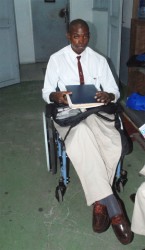Roger John hopes to be one of the first persons to benefit from a commercial bank loan secured by the Small Business Bureau under the first phase of the US$10 million Micro and Small Enterprise Develop-ment (MSED) project.
It will be applied to what he hopes will be a successful agricultural project that seeks to combine conventional agriculture with aquaponics—a system in which the waste produced by farmed fish supplies the nutrients for plants grown hydroponically—on a 10-acre plot of land which he has acquired on the Soesdyke-Linden Highway.
It is a formidable challenge for the 50-year-old resident of Buxton whose knowledge of crop cultivation of any kind has been secured mostly through reading. But that is not John’s only challenge; the equally imposing one reposes in the fact that he is wheelchair-bound, paralysed from the waist down on account of a fall from the verandah of his home (in Seaforth street Campbellville at the time) after a night-out with his friends in July 1987. Two complex operations and six years of “crying and contemplation” finally brought Roger John to the realisation that he had no choice but to rebuild his life around the reality of the permanent loss of the use of his legs.
His focus on some measure of physical and, mostly, mental rehabilitation took him to religion, to working with his hands in a woodworking shop run by his brother in Georgetown and finally, and perhaps, crucially, to the computer. The internet has kept him in touch with the world.

His hopes of running a successful business are linked to a determination to prove to the world that his physical limitations do not amount to a handicap.
Several years ago he decided to use his strength, his hands, to carve objects and got as far as carving pieces as gifts for friends. The exposure in his brother’s workshop helped. Once the idea of moving to the level of starting his own business emerged, however, he experienced his first encounter with the harsh world of the conditionalities associated with business financing. He does not blame the commercial bank that turned aside his application on the grounds of a lack of the required collateral. “They have a job to do,” he says. Besides, he admits that despite his limitations he is not particularly mindful of “special favours.”
In 2003, it appeared that John’s project would get off the ground. It was embraced by the Linden Economic Advancement Project (LEAP) and financed by the Linden Economic Advancement Fund (LEAF). Shortly after it was green-lighted and as Roger was preparing to relocate to Linden the house that had been set up for his occupation was destroyed by fire. It was a setback from which he did not recover and eventually the management of the project summoned him to a meeting at which they told him that the facility had been withdrawn.
“The truth is that they had done all that could have done for me,” John says. Three years ago another approach to a commercial bank to secure financing for his project ended in yet another disappointment.
John concedes that the varied experiences of a life spent battling to secure his own independence against the background of the loss of the use of his legs brought periods of frustration. He survived those, he says, by resorting to prayer and coming to recognise that his circumstances required him to be stronger.
Rather than immerse himself in his disappointments, John reached out to the United Nations led Empretec Project through its Guyana Chapter. The mission of Empretec is to work to support entrepreneurs to build innovative and internationally competitive SMEs. Over a period of time, he has undergone training in a range of disciplines including Management Principles and Business Ethics. “I believe that these programmes have helped prepare me for the period ahead,” John says.
Much of his time is now spent preparing for what he anticipates will be the formal startup of his project “in a matter of months”. He says the Small Business Bureau has already endorsed his project, the proposal for which is all but complete. He has already begun to think like an entrepreneur, spending his time contemplating project infrastructure, value-added commodities, domestic and external marketing and farm organisation. He envisages that over time the project will absorb up to $30 million in investments.
Asked about the challenges of being a full-time farmer without the use of his legs, John says he believes the application of technology will reduce the extent of his own physical effort. “Apart from which, part of the whole objective of the project is to employ people,” he adds.
That, he believes, will come during the agro-processing phase of the exercise. “This is not only about growing, reaping and selling. It is about adding value. Value-added products mean new and different markets locally and possibly abroad. I know that this is a considerable ambition, but I intend to give all that I can to this opportunity,” he says.




